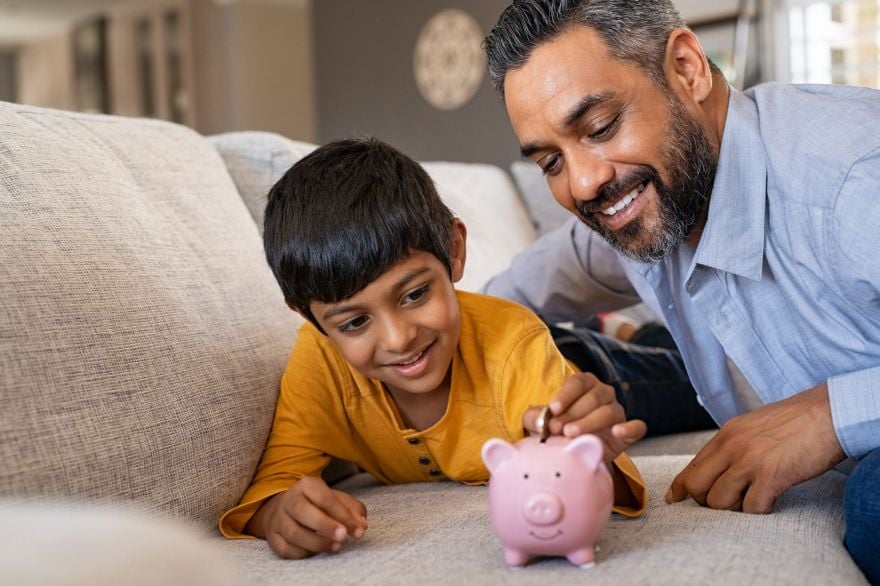
Teaching children money skills and other positive financial habits at an early age is one of the most important things parents can do to help their kids succeed. Unfortunately, financial literacy lessons often get overlooked.
To help you with teaching your children about finances, here are seven ways you can make financial education engaging and approachable no matter the age.
Teach math with sugar packets (early childhood)
Sugar packet math is an easy way to teach basic math skills while at a restaurant, and a great diversion tactic while you wait for your food. Use packets to introduce early math equations like 2+2 and 5-1. Then, slowly evolve the game to frame the questions around money.
For example, give them a certain number of sugar packets, explaining that white sugar packets represent money from their paycheck and pink packets are their monthly bills. Then ask them if they’ll have enough to pay for dinner or to buy a new toy.
When you make learning fun and engaging, a young child’s understanding of math and money starts to develop without them even knowing it.
Play pretend store (early to middle childhood)
Turn any room of your home into a pretend store to teach money skills to children in a playful setting.
First, have them select an array of items already in the house, from cereal boxes to action figures and sports equipment to dresses. Then, have them arrange the products neatly on shelves and sofas to make it look like what they might see at a real store.
Next, with crayons and scraps of paper, price each item. The ‘cost’ of the products in the store doesn’t have to be accurate. Instead, focus on keeping the figures small, between $.10 to $1.00, for example.
Finally, give your children a few dollars and some coins and have them go shopping.
For a variation on this game, switch roles and you shop while they work the register and make change from your purchases!
By learning to make choices and live within their means, you are subtly teaching your children money habits for life.
Clipping coupons game (middle childhood)
While many coupons have gone digital, many of us still clip coupons from the paper or remember our parents doing it.
- Option 1: Buy a newspaper, sit down at the kitchen table with your kids, pull out the coupons, and go through them together to find both products you use regularly and a few new snacks they might like to try. Let them safely cut out the coupons with kid scissors.
- Option 2: Open your favorite digital coupon app and do the same thing!
Throughout this activity, talk to them about the savings ($1 off a single product, $2.50 off when you buy two items, etc.) and why it’s important to look for savings before even going to the store.
Talk through your own money decisions (middle childhood and up)
Children are constantly learning from the actions and words of their parents. So don’t underestimate the simple power of including them in appropriate conversations about money or talking to them about the financial things you’re doing. Every transaction is another opportunity to reinforce the lessons you’re teaching.
When you hit up the ATM:
- Discuss how much cash you are taking out
- Explain that the money comes from your checking account (money you already have, not a loan or a credit card)
- Discuss what you’ll use the money for
They may ask if that’s a lot of money, if you have more in the bank and how you will get more. These are great questions to field from kids that will continue normalizing teaching children money skills.
When you make a mobile deposit with your bank app: Tell your children where the money came from (Did you get paid? Receive a rebate check? Get a gift from a relative?), and what you plan to use it for once it’s available in your account. Explain whether it’s going into your checking or savings account and why.
During trips to the grocery store:
Be open about your decisions. Why are you choosing an item on sale over one that is not and why are those dollars saved every week important in the grand scheme of your own budget? You can also connect this to the coupon game from our third idea.
Give your kids an allowance (all ages)
Many parents give their children an allowance to spend how they see fit, which provides an excellent opportunity to teach children about finance. You can tie part or all of their allowance to different household chores and good grades, which can teach work ethic and goal-setting.
This allows for opportunities to discuss budgeting, saving, and financial responsibility with your children and, even more importantly, reinforce those discussions by allowing them to put them into action.
Create a kid-sized budget (all ages)
The numbers will be small, but budgeting is all relative. For example, if your child earns $5 per week, help them plan how to divvy up that money in their first budget. Your child’s budget for $5 per week might look something like this:
- $2.50 to savings
- $2.00 for spending money
- $.50 to the charity of their choice
Learning to budget is a money skill that will benefit your children for years. Encouraging donations to charity will help teach your children the importance of giving back.
Open a savings account (middle childhood and up)
Many banks offer children’s savings accounts with no fees and no minimum balance requirements. Open an account and encourage your kids to deposit a portion of their allowance, birthday/holiday gift money, and other income regularly. Check their balance with them each week. And if they have specific items they’re saving for, help them track their progress.
As your children transition to their teenage years, help them open regular savings and checking accounts. This is especially important as they approach their college years.
Saving is about delayed gratification, which isn’t natural for many children or teenagers. It not only helps teach important financial concepts; it also teaches the importance of setting goals and planning for the future. Whether your child is saving for a new pack of Pokémon cards or your teen is saving up to buy their first car, saving money with a goal in mind is a fantastic learning opportunity.

